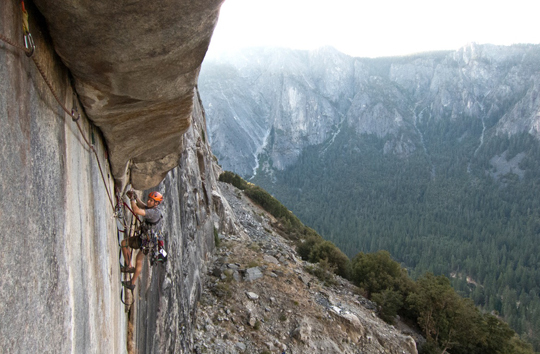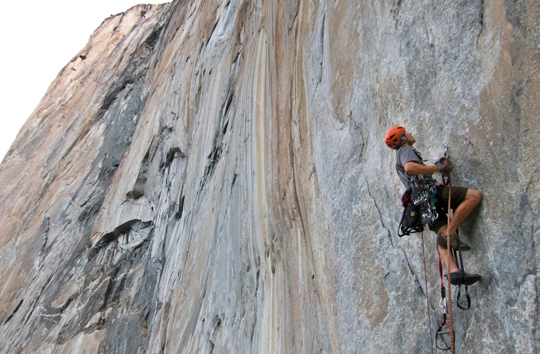
Zodiac (VI 5.7 A2, 1,800′), El Capitan, Yosemite Valley. Ben Doyle following Cheyne Lempe on their one-day ascent El Capitan’s southeast face. [Photo] Cheyne Lempe
Up to 3,000-foot vertical walls, 5,000 routes, 1,200 square miles, 150-180 days of climbing per year and two–count them: Jesse MacGahey, Ben Doyle–two full-time Yosemite climbing rangers. This year, they organized a grant-funded, volunteer-fueled program to help manage and protect the park’s climbing resources and bridge the historically wide gap between rangers and climbers. This series of articles is a record of the Climber Steward program’s inaugural year in the world’s most popular climbing area.
In this installment of the Diary of Yosemite’s Climber Stewards, Ben Doyle climbs El Cap’s Zodiac in a day in hopes of promulgating cooperation between climbers and park rangers. –Ed.
If you fell unroped from the crux of Zodiac, on El Cap’s southeast face, you would fall more than 1,000 feet without touching the wall and land more than 50 feet from its base. And that was my first thought when my alarm woke me at 4:30 a.m. I had a long day ahead.
Sometimes when I wake up for a big day of climbing, I’m awake before my alarm, ready to go. Not that morning. I was tired, and I struggled out of bed. I put on my uniform and headed to the office.
Cheyne Lempe and I decided to climb El Cap last week when we were touring the base in preparation for a trail use study. “I gotta get on The Captain,” Cheyne said, staring up at the Shield headwall leaning out over us. “We’re due for a Zodiac patrol,” I suggested. “Let’s do it,” he agreed. “How about Friday?”
Historically, there is a tension between climbers and Yosemite rangers, maybe because of a defiant current in climbing culture, maybe because of bohemia resentment in ranger culture. Maybe both, it’s hard to say. But that was then. Now, climbers and rangers are both taking great strides to reconcile. This social momentum is part of what motivated me to do a one-day patrol on Zodiac. It said to rangers, “Difficult climbing objectives are worthy of patrol,” and to climbers it said, “Yosemite rangers understand why you’re here.”
As I contemplated the pitches ahead, I guzzled my coffee and started the patrol truck. In spite of the reconciliation movement, it was strange to drive a ranger truck with reds and blues to climb El Cap in a day.
As I drove I felt the anxious edge fluttering in my chest. Too much coffee? Too ambitious an objective? I had climbed Zodiac twice before, but never in a day. I took a deep breath and tried to let go.
This is my job, I reminded myself. I should be competent enough to do this safely.
Part of that competence is to know when to hold ’em, and to know when to fold ’em.
I flashed my lights as I approach Camp 4, and Cheyne materialized from the shadows
As we hiked, the El Cap constellation flickered above us; headlamps flashed as wall parties ate breakfast and began their day. We checked for food storage issues below the Dolt Tower rappels. Food storage compliance is a key part of any El Cap patrol, and I often wish for more time to walk this route. The local bears patrol the base daily, and they don’t write warnings.
At the Enchanted Forest, an out-of-place island of oaks crowded against the wall on the expansive El Cap talus, we stopped for moment and looked into the dark pit where the cliff disappears into a gap between the wall and a flat slab at the base. El Cap seems infinite here, as if it continues endlessly into the depths.
When we arrived at the base of Zodiac, our new friend, Oliver, peaked out over the edge of his ledge two pitches above us. Oliver was soloing his first El Cap route, and was humping loads to the base all week. Meanwhile we are trying to do this route in a day–and without excessive risk. I am on the clock, in uniform, and I have an explicit directive to climb as safely as possible.
We got our kit in order, I ran a quick risk assessment analysis and began leading at 6:30 a.m. I’m scared, I’m slow. What if this pitch takes forever? And as that thought occurred to me, two guys walked up over the talus.
“What are you climbing?” they ask.
“Zodiac,” Cheyne replies.
They saw our stubby haul bag and asked, “You gonna do it in a push?”
“Yeah. Are you doing the East Buttress?”
“Yeah…. Good luck.”
“See you at the top,” Cheyne joked.
They looked up at me. I was cruxing, still only 10 meters off the ground. “Not at that pace you won’t.”
“Thanks for the encouragement,” Cheyne said, and they sauntered away toward the East Buttress.
As we passed Oliver, he invited us to stand on his ledge and then asked questions about the climbing ahead. Still on patrol, I took a quick look at his waste disposal system, and clipped through the rivet ladder while Cheyne hauled our bag and described the cruxes to Oliver.
After those first few pitches I found my pace, and the anxiety faded.
A funny thing happens when I hit my flow on the wall. I get so focused and relaxed that I lose all verbal control and censorship. I began rapping in free association. Cheyne does this as well, and as I free-styled my way up the Black Tower, Cheyne warbled encouraging nonsense back at me.
I finished my block at the clean white expanse called the Gray Circle. The route travels for three steep pitches through this feature. We were eight pitches deep and six hours into the climb.

Climbing Ranger Ben Doyle starting pitch three of 18. [Photo] Cheyne Lempe.
I re-racked, turning all of the biners from gate-out to gate-in, as Cheyne prefers. Cheyne arrived and I passed him the chest harness with the gear. He pulled off the anchor onto a cam hook. “Gotta start my block right,” he remarked and climbed up into his second step, fingering tiny side-pulls for balance. He looked down at me with cartoon eyes, and stuttered, “I’m scared.”
Half true, it seemed, but it didn’t slow him down. In 45 minutes he’d finished a long, steep, difficult pitch, and an hour after that he finished the Nipple.
The Nipple is probably the most sustained and strenuous pitch on Zodiac. After 70 feet of inverted cam hooking on an overhung, diagonal flake, the leader faces the offwidth crux. After the crux, insecure brass nuts and hand-placed beaks gain easier ground. If you fell unroped from the crux of Zodiac, on El Cap’s southeast face, you would fall more than 1,000 feet without touching the wall and land more than 50 feet from its base.
When I finished jugging the pitch, Cheyne was almost out of rope, soloing, 30 feet above me. I put him on belay and tagged up the gear.
I turned away from the wall and gazed out at the Cathedral Rocks. I adored the glaze of orange and green lichen dripping down Higher Cathedral Rock, and the sweeping slabs of Middle. Higher and Lower Spire stood at attention like father and son. I felt my affection climbing from my belly up into my throat, and for a moment I choked back tears.
I feel this same way when I get my first views of Indian Creek. I don’t know why these landscapes affect me this way, but it’s the same way I feel as when I go home. This affection is my deepest reserve of motivation to share this place, and to protect it.
Three hours later, we were a pitch from the top. “Think we should go down?” I asked.
“Yeah, we better, it could get pretty hard to bail if we go any higher,” he replied. I laughed and looked down, 2,000 feet to the talus below.
At 7:00 p.m. we topped out and raced down the East Ledges before the light was gone.